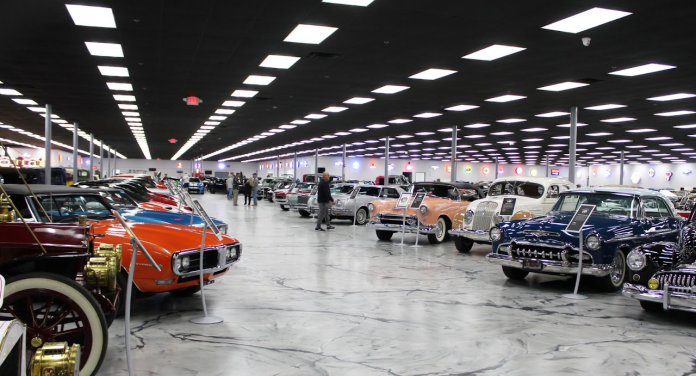
Classic cars are loved for many reasons. Some people are born with a passion for classic cars. Others acquire it through the love and support of friends and advertising. Sometimes people awaken with a burning desire to restore classic cars. It doesn't matter why, we all have had that urge to purchase a vintage car. If this sounds familiar, you can read on to discover more about the many types of classic cars in America.
Ford F-series pickups
Ford F series pickups may be familiar to anyone who has ever owned an American classic car. These cars have been around for decades and are still the best-selling vehicles in the country. Here are some interesting facts about these classic vehicles. Below, we have included a few. Below are some facts about Ford F-series trucks.
Chevrolet C10
The Chevrolet C10 pickup trucks were first introduced in 1960. It was a precursor to the Ford F-Series pickup truck and Dodge D-Series pickup truck. There were four generations of it in production. There were many variations of the C10, including the first cab over model. Also, there was a wide range of trim and engine options. Unlike its predecessors, the C10 has remained in production for more than forty years.

Chevrolet Bel-Air
Their timeless design is what gave rise to the classic 1950s cars. The Chevrolet Bel Air is an example of such a car. It is instantly recognisable. From the first Tri-Five racers to the fifth and sixth generation muscle cars, this car has become an icon of American culture. The car combines form and function to offer the best of both. A Bel Air that is maintained well will make you feel like an actor.
Chevrolet Corvette
The iconic 1966 Chevrolet Corvette remains one of America's most loved and iconic automobiles. It was well-known for its style and elegance. It appeared in numerous movies and Country music. The car was produced from September 1965 until July 1966. The new 427-cubic inches engine was a big leap forward for its time. It was originally rated at just 450 HP. The car was able to accelerate from 0-60 mph at a speed of 15 mph. It was nevertheless one of the most popular vehicles ever made and its popularity was rapidly rising.
Pontiac GTO
The Pontiac GTO (performance car) was produced between 1964 and 1974. It was designed to be a high performance car with large displacement engines and unique body lines. Because of this, it was more expensive that comparable Mopar models. Below are some highlights. If you're in the market for a classic car, the GTO should be on your short list.
Chevrolet Chevelle
The foundational redesign of the Chevrolet Chevelle's third generation was done. New, stronger frames were created with wider rear axles, wider tires, and revised geometry. Hydraulic camshafts and hardened seat valves increased the engine's reliability. The engine was fitted with a 4-speed manual or optional Turbo Hydra-Matic 3-speed auto transmission.

Ford Mustang
The first model of the Ford Mustang was introduced in 1964 and has become an icon of the decade. Its reliability, affordability, and great design have attracted millions of admirers. Ford has been producing special edition Mustangs for years to enhance power, style, as well as exclusivity. Collectors now spend a significant amount of money to own one of these cars. Which Mustang model is the best Mustang version? Here are five great reasons to purchase a classic vehicle.
FAQ
What are the requirements of an auto technician?
You need to have high school diploma or GED and good grades in English as well as maths. It is also necessary to be able both to read and to write. You will need to pass a written test and then go through a series of practical exams before being allowed to start work.
What is the length of an automotive training course?
An automotive course lasts 3 years.
The first year is spent on theory, learning all about cars. The second year is spent on practical training where you learn how to drive, fix engines, and do other mechanical jobs around the car. The last year of your training is spent on practical training, where you learn how to fix real-world problems.
Is a career in automotive mechanic promising?
There are many exciting opportunities in the automotive industry for people who are driven to achieve excellence. Working hard and learning from others is the best way to be successful in this field.
Because you will be spending most of your time communicating with customers and employees, you will need excellent communication skills. It's important to be flexible and willing to travel. This will make commutes difficult.
If you're interested in pursuing a career in automotive, consider taking classes at community colleges and universities. Many schools offer programs designed specifically for students interested auto repair, sales, and customer services.
If you decide to pursue a degree, you should study mechanical engineering. It's possible to get a bachelor's degree in just four years.
Many employers will hire graduates straight out from school. Therefore, it is a good idea to look for employment while still pursuing part-time studies.
After you've finished your education, it's likely that you'll need to go through some training before you can be hired as an auto technician.
This means you'll need pass exams like the Automotive Services Excellence (ASE), certification exam. This test covers topics including engine maintenance, brakes, steering systems, suspension, and more.
Once you pass the ASE test, your license can be applied for by the National Institute for Automotive Service Excellence.
A license allows you to perform repairs on vehicles owned by private individuals. You will be compensated based on how many services you performed.
Not all states require licensing. You will need a license if you want to work in a different state.
Some states will not issue licenses until an individual has completed certain training. This could be you.
What jobs are available for car mechanics?
Car mechanics can find work in three areas:
-
Automotive repair shops
-
Dealerships
-
Independent garages
Automotive repair shops
Most people think of this as the first step to becoming a mechanic. This is the best way to get started. Either you can work in a shop that is owned by another person or start your own business.
If you are interested in working at a shop you will need to apply for membership to a union. After you are accepted to the union, you will receive training from it.
After completing the training, you'll be ready to start work.
You will need to register if your garage is going to be open. You'll need to meet certain standards after you register.
After you have registered, you will be issued a license to operate your garage.
Your license allows for minor repairs and spare parts sales. You can't fix major engine problems with your license.
Customers will expect you to not only sell spare parts but also provide advice and guidance.
Dealership jobs
Most dealerships employ mechanics that specialize in one aspect of the vehicle. They may be trained to replace or repair tires, or they may specialize in brakes.
Some dealerships hire general mechanics to handle all aspects of car repair.
Some positions require that applicants complete training before they can be allowed to work. This allows employers to pick the right candidates for their jobs.
Some dealerships even recruit graduates straight from university. These graduates are familiar with the fundamentals of mechanical engineering so they can easily learn about cars.
Independent garages
Independent garages don't belong to any particular dealership. Instead, they tend to focus on providing high-quality service.
Independent garages don't have to be associated with any particular company. This allows them to offer higher wages. This means that these jobs are usually more lucrative than those at dealerships.
Independent garages can be just as good places to work, but this does not mean they are better. Many owners prefer to control their businesses themselves, rather than delegating it to employees.
You might find yourself working long hours but having no control over what happens in the day.
Also, expect to make lower wages than if your job was at a dealership.
It's possible to switch between jobs. Ask your employer if you would like to work as a mechanic at a dealership.
You could also apply directly to an owner of a garage if that's what you want.
It's not always easy to find a job. You can earn more depending on many other factors.
For example, the type of vehicle you repair and whether you charge extra for labor.
How long is an automotive mechanic apprenticeship
An automotive mechanic apprenticeship takes around three years to complete. It includes two years of school and two years as an apprentice. The first year teaches you all aspects, from theory to practical skills and safety procedures. You'll also learn how tools can be used safely and efficiently during this year. After you have completed the first year of training, you will be able to spend an additional year on-the job learning different trades. You will have the opportunity for formal training during these years.
The final year of the program is spent gaining qualifications and becoming certified in the field. These include NVQs (National Vocational Qualifications), that are given after passing specific industry exams. There are also HNCs (Higher National Certificates), which cover general subjects like management, business administration, customer service, and more. For those interested in pursuing certain trades, City & Guilds certificates are available.
What is the difference?
They are both similar, but not identical. An automotive technician maintains cars, while a mechanic repairs them.
A mechanic must possess good manual dexterity, and be able perform simple tasks efficiently. They should also be able correctly diagnose and repair any problems.
An automotive technician is required to have more technical knowledge than a mechanic. They must be able and able to read blueprints as well as use tools like drills or wrenches.
They must be able and competent to safely perform complicated procedures. They must be familiar with all types of electrical and engine systems.
They must also be able comprehend how the various parts interrelate with one another.
This means that mechanics usually make less money than automotive technicians. However, both careers offer great opportunities.
Statistics
- There were 749,900 jobs available for automotive service technicians and mechanics in 2016, which is expected to grow by six percent through 2026. (jobhero.com)
- According to the BLS, total auto technician employment is expected to exceed 705,000 by 2030. (uti.edu)
- Apprentice mechanics earn significantly less hourly than mechanics who have completed training, with a median wage of approximately $14.50 an hour, according to PayScale. (jobhero.com)
External Links
How To
How to properly diagnose and repair your vehicle
To determine if your car needs repairs, you should first look at the symptoms that your car presents. You can then follow these steps for a proper diagnosis of your vehicle.
-
Check engine lights. Inspect the dashboard light indicators. These include the engine lights, the oil pressure gauge and the battery light indicators. The RPM gauge and coolant temperature gauge should also be checked. You may have a problem with your vehicle if any of the indicators are flashing for more than a few days.
-
Pay attention to the treads on your tires. Tires that are worn can cause issues with handling and braking. You should inspect the treads on your wheel. They should be smooth and clean. The best way to do this is to remove the wheels and take them off. Check the tread condition with a flashlight.
-
Monitor the level and consistency of your brake fluid. It is important to keep track of how much brake fluid you have in your car. You can ensure that your brakes are working properly by monitoring the level of brake fluid in your vehicle. If the brake fluid level is low, your brakes might fail when you apply pressure to them.
-
Check the suspension system. Vehicles usually have a suspension system that helps absorb shocks and vibrations while driving. This suspension system provides greater control and smoother acceleration and deceleration. Your vehicle might feel wobbly, or shake uncontrollably if it has a bad suspension. You can test if your vehicle has a suspension problem by putting weight on either the front or back axle to see how it moves.
-
Examine your steering column. Steering columns connect the steering wheels to other parts of the vehicle. Sometimes, steering columns are damaged by accidents. It is recommended to replace any steering column that feels loose, or shakey.
-
Pay close attention to the exhaust tube. Exhaust pipes move gases from combustion chamber to atmosphere. Your cabin will be effected if your exhaust pipe cracks or leaks. If your tailpipe bends, it is important to fix it immediately.
-
Take a look under your hood. Check under your hood for any unusual or missing components. Your engine could be leaking fluids. A professional technician should be contacted if your engine compartment emits an unusual smell.
-
You should inspect your air filter. The air filter in your vehicle collects dirt and dust from the environment. A dirty air filter causes your vehicle to run poorly. Replace your air filter regularly.
-
Check the fan belt. Your vehicle's fanbel connects the engine and transmission. If the fan belt is damaged, the engine won’t turn. It is very easy to replace your belt. You will need a screwdriver, pliers and a pair of pliers.
-
Check the radiator hose and hoses. The radiatorhose carries water from your radiator to the engine. If it becomes cracked or damaged, it can leak hot liquid onto the engine. To repair the leaky hose, all you need is a pair if needle-nosepliers.
-
Make sure you have the windshield wipers checked. Windshield wipers use electricity to wipe away rain and snow. They can leave streaks on your windows glass if they stop working. Change the washer fluid to fix the problem.
-
The battery cables should be checked. The battery cables supply power to your car's electrical systems. If you are replacing batteries, disconnect the negative cord first. Failure to do so can damage your alternator.
-
Be sure to check your headlights. The headlights will illuminate the road ahead. Poor visibility can result if the headlights don't function properly. Inspect the bulbs for signs of burnt out.
-
Check the lights. When you approach them at night, the lights warn other drivers. If one doesn't work, it could distract you and lead to an accident.
-
Check the brakes. Brakes will reduce the speed of your car in case of an accident. You could lose control of the car and cause a crash if they don't work properly.
-
Change the oil. Your engine will stay lubricated by the oil. It prevents metal parts from rusting too quickly. It is recommended to change the oil each month.